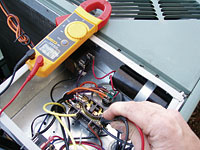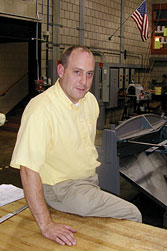
Do you have the tools you need to meet these changes? Wouldn't it be a good idea to start learning how to use them properly now?
According to the EPA, "The proposed draft specification represents a major shift in the EPA's approach to the air-source heat pump and central air conditioner market." Specifically, the EPA is exploring a two-tiered system of labeling for Energy Star products. Under the proposal currently under review, manufacturers would label equipment as it leaves the factory, but a second labeling process would also occur at the jobsite once installation is completed and airflow and refrigerant flow have been independently verified.
A note in the EPA's eligibility criteria states: "While there are other elements of the installation (e.g., ducts), EPA is proposing to only require that sizing, airflow, and refrigerant charge be addressed in the context of this draft specification and that only airflow and refrigerant charge be verified by an independent party."
The thought of this is making some manufacturers and service technicians shudder. After all, proposing third-party verification is one thing; actually finding an economical way to get it done is another. However, in the eyes of many contractors and technicians, it is long overdue. Even without the energy savings in the picture, doing the things cited in the criteria will improve customer comfort, significantly reduce equipment failures, decrease callbacks, improve indoor air quality (IAQ), and provide environmental benefits.
One might ask how all this will be done; remember, the third party is only going to verify the charge and airflow. Technicians can get these areas right the first time by using modern instrumentation, free software, free check sheets, and hints and tips - working smarter, not harder.

Tools You Will Need
Before you begin, take a look at the contents of your toolbox. What do you have?To do the job right, you will need a few digital instruments - nothing that will break the bank, just the tools that are required to do the job right the first time.
A small investment in tools will provide you or your employees with dividends, lower the amount of time it requires to perform service, remove the guesswork, and back you up with the documentation required to ensure that the airflow and refrigerant charge are within the manufacturer's specifications.
I recommend using the following:
Additional instruments can provide still more benefits to the technician and the consumer:
Additionally, you can download the following software for free:
Why Digital?
Digital instruments are faster, more accurate, reduce the requirement to carry around pressure-temperature (P-T) charts, eliminate guesswork, increase productivity, provide repeatable test results, increase professionalism ... and they are really cool!There is a difference between "toys" and "tools."
Toys are digital instruments that looked cool and were fun to play with for a while, but are now behind the seat of the truck bouncing around because all they proved to be good for is winter weight. They never were reliable, they drifted, didn't take the same measurement twice, and generally didn't live up to your expectations.
Tools will be used by you every day. They provide you numerous benefits and give data that you can count on.
If you carry a laptop PC on the truck, or you want the ability to verify installations at the shop, the digital psychrometric chart from www.handsdownsoftware.com will prove to be an invaluable tool for the field and/or office. If you upgrade to the professional version for a few dollars more, you can gain other benefits including the ability to provide your clients with performance charts and reports that include your company name and logo.
Digital gauges, specifically the Testo 523, can be ordered in a kit with software and temperature probes that allow the user to print reports from information gathered in real time as the testing and system operation is verified.
A digital manometer can be used for reading duct static pressure, pressure drop across a coil, total external static pressure, and manifold pressure in a furnace. Manometer models with fine resolution and proper dampening are even sensitive enough to read velocity pressure.
A combination wet bulb/dry bulb/rh thermometer-hygrometer is used to check the initial and final conditions of the air that will be conditioned. Some manufacturers have instruments that read in 0.1ÞF and are traceable to NIST standards. Digital products also eliminate human error that can occur when reading the sling psychrometer; errors from using tap water instead of distilled; and reduce time, as readings are obtained quickly and easily.
You also need to obtain a high-quality digital multimeter. Remember, HVAC techs should be carrying instruments with a CAT III rating or higher for safety's sake. Accuracy is second only to safety, and you get what you pay for - don't skimp here.
Time To Go Digital
If you haven't gone digital yet, now is the time. The manifold gauges you're probably using now were originally developed for use with SO2 (sulfur dioxide) and were later adapted for use with subsequent refrigerants.As system refrigeration charges are becoming more critical, and the window of proper operation is tightening, bourdon tube gauges are not always accurate enough.
Due to the error inherent with bourdon tube technology from effects of ambient temperatures, atmospheric pressure, and the fact that mechanical gauges are most accurate in the center of their range, they cannot provide the accuracy and repeatability that are desired now and into the future.
Digital gauges are accurate over the entire working range, and do not hold refrigerant gases inside their porting (bourdon tube) that can affect the pressure readings.
Your old gauges also do not provide data logging capabilities, nor do they typically receive regular calibration now that they are equipped with low-loss hoses. With digital, I have yet to spill the gauge fluid out of my digital manometer, I haven't forgotten to wet the wick of my digital hygrometer, and I have never field calibrated my gauges.
Digital is just easier.
Now that tools are out of the way, let's check the equipment.
Most of what I am suggesting, you will only need to check once. It is not necessary or responsible to check the charge in the equipment that you service on a yearly basis. It should only be checked when a problem is suspected. A few measurements and knowledge of the design operation will usually be all that is needed to verify the charge without gauges. Airflows will not change significantly if the equipment is maintained properly.
Pressure drop across the coil can be recorded and verified, and the refrigerant charge can be checked without gauges once the design conditions are established. The initial commissioning of the equipment will take a few minutes more than a preventive service check, but with digital instrumentation, it will get done faster and more accurately than you would imagine.
I can guarantee you that a second or third technician equipped with the same tools can measure and get the same results. I have reviewed thousands of furnace, heat pump, and air conditioner checks, and I know the repeatability of tests done with digital instrumentation provide consistent results.
Jim Bergmann, The News' 2004 HVACR Instructor of the Year, teaches at Cuyahoga Valley Career Center, Brecksville, Ohio.
Publication date: 05/23/2005

Report Abusive Comment